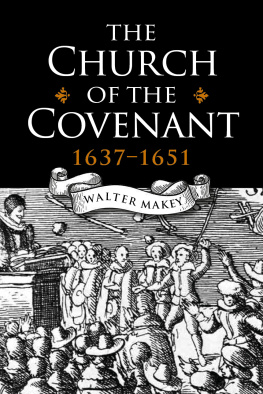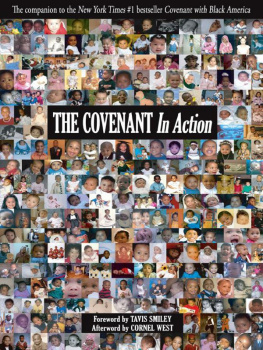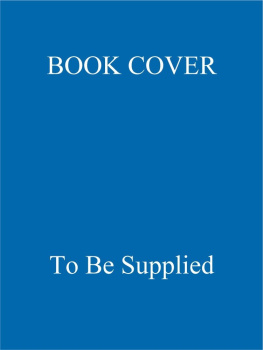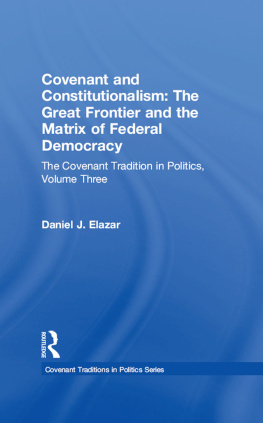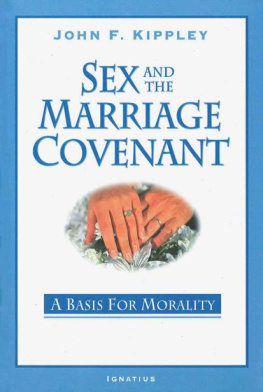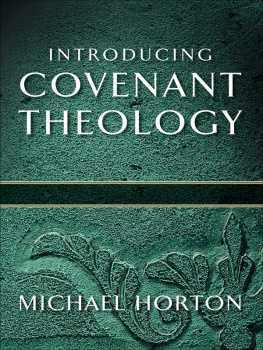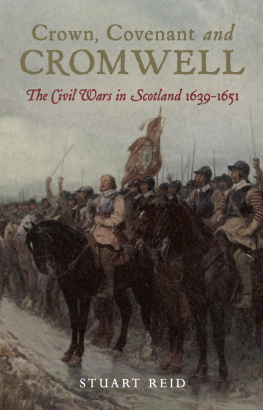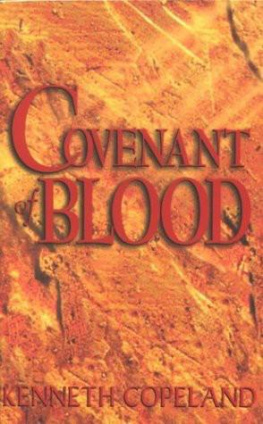Walter Makey - The Church of the Covenant 1637-1651
Here you can read online Walter Makey - The Church of the Covenant 1637-1651 full text of the book (entire story) in english for free. Download pdf and epub, get meaning, cover and reviews about this ebook. year: 2021, publisher: Birlinn, genre: Detective and thriller. Description of the work, (preface) as well as reviews are available. Best literature library LitArk.com created for fans of good reading and offers a wide selection of genres:
Romance novel
Science fiction
Adventure
Detective
Science
History
Home and family
Prose
Art
Politics
Computer
Non-fiction
Religion
Business
Children
Humor
Choose a favorite category and find really read worthwhile books. Enjoy immersion in the world of imagination, feel the emotions of the characters or learn something new for yourself, make an fascinating discovery.
- Book:The Church of the Covenant 1637-1651
- Author:
- Publisher:Birlinn
- Genre:
- Year:2021
- Rating:3 / 5
- Favourites:Add to favourites
- Your mark:
- 60
- 1
- 2
- 3
- 4
- 5
The Church of the Covenant 1637-1651: summary, description and annotation
We offer to read an annotation, description, summary or preface (depends on what the author of the book "The Church of the Covenant 1637-1651" wrote himself). If you haven't found the necessary information about the book — write in the comments, we will try to find it.
The Church of the Covenant 1637-1651 — read online for free the complete book (whole text) full work
Below is the text of the book, divided by pages. System saving the place of the last page read, allows you to conveniently read the book "The Church of the Covenant 1637-1651" online for free, without having to search again every time where you left off. Put a bookmark, and you can go to the page where you finished reading at any time.
Font size:
Interval:
Bookmark:
THE CHURCH OF
THE COVENANT
16371651
THE CHURCH OF
THE COVENANT
16371651
Revolution and Social Change
in Scotland
WALTER MAKEY
Edinburgh City Archivist

This eBook was published in Great Britain in 2021 by John Donald, an imprint of Birlinn Ltd
Birlinn Ltd
West Newington House
10 Newington Road
Edinburgh
EH9 1QS
First published in Great Britain in 1979 by John Donald
Copyright Walter Makey, 1979
eBook ISBN 978 1 78885 424 5
The right of Walter Makey to be identified as the author of this book has been asserted by him in accordance with the Copyright, Designs and Patents Act 1988.
All rights reserved. No part of this publication may be reproduced, stored, or transmitted in any form, or by any means, electronic, mechanical or photocopying, recording or otherwise, without the express written permission of the publisher.
The publishers gratefully acknowledge the support of the Strathmartine Trust towards the publication of this book
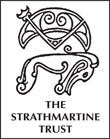
British Library Cataloguing-in-Publication Data
A catalogue record for this book is available on request from the British Library.
Acknowledgments
THIS book is a work of many hands and I should like to thank all those who have helped in the long process of its completion. The greater part of the research was necessarily done in short spells and at odd moments. This would have been impossible without, on the one hand, the assistance of the staffs of the Scottish Record Office, the National Library of Scotland, the Registrar Generals Office, and the Edinburgh Central Public Library and, on the other, the generous lending policies of the Libraries of New College, Edinburgh and the University of Edinburgh. They are all wholeheartedly thanked for allowing me to use the materials in their custody and for the courtesy with which they always provided them. I should also like to thank my employers, once Edinburgh Corporation and now the City of Edinburgh District Council, for permission to use the records in the City Archives with which I have more than a passing acquaintance. I am grateful to the Church of Scotland for numerous kindnesses, not least for depositing so many of its records, national and local alike, in the Scottish Record Office and thus making them generally available; my thanks are also due to the kirk session of St Cuthberts and to the presbytery of Stirling for permission to examine their minutes before they had been so deposited. Avondale and Penicuik figure prominently enough in the theme running through this book and each disclosed its secrets through the family papers of its principal proprietor; my debt to His Grace the Duke of Hamilton and to Sir John Clerk of Penicuik Bt. is perhaps sufficiently obvious. Some of the ideas explored in this book have already been aired in a paper read to the Scottish Church History Society in 1970 and I am grateful to the Society for its permission to use them again.
Many of the issues raised in this book have been discussed, seldom heatedly but always profitably, with the members of Professor Gordon Donaldsons postgraduate seminar. It was perhaps a fortunate coincidence that several of them had sixteenth century interests; my attention was inevitably attracted to the origins of the society with which I was directly concerned. Dr Margaret Sandersons work has had a vital influence on my own; but all concerned, whatever their period, have left their mark. Dr Rosalind Marshall shares my fascination with the Hamiltons, Edward Cowan my interest in Montrose and Argyll, Dr Michael Lynch my enthusiasm for Edinburgh, Frances Shaw my respect for testaments, and Dr Arthur Williamson my belief that argument is always productive. At one time or another, I have debated almost everything with the Reverend Dr John Todd and many of my more extravagant notions have perished in the small hours of the morning. I thank them all; but my greatest debt and it is a debt shared with all who are seriously concerned about the study of Scottish history is to Professor Donaldson himself. Without his erudition, this book would have been the poorer; without his encouragement, it would not have been written at all.
It is fair to say that I disagree with Dr David Stevenson about the nature of the Scottish Revolution, but I should like to record my appreciation of his work. He has produced a dispassionate narrative of the period and thus a solid foundation for research. Over the years, I have discussed various aspects of the subject with Dr William Ferguson, Dr John Moore, Professor Valerie Pearl, Dr John Imrie, Dr Ian Rae, Dr Julia Buckroyd, Lady Christian Hesketh, Elspeth Yeo, John di Folco and Richard Dell. I am similarly grateful to John Tuckwell of John Donald Publishers Ltd. for many helpful suggestions and for guiding an occasionally wayward author safely into print. Like all the others, he is absolved from the consequences of his kindness; errors of fact and absurdities of interpretation remain the inalienable property of the author.
A special word of thanks is due to all those who typed or checked the various drafts, and particularly to Ann Munro who triumphed over my hand-writing to produce an accurate rendering of the final version.
I must finally thank my wife, Phyllis, for hours of checking, for disentangling a dozen mixed metaphors and, not least, for patiently enduring a husband who periodically wandered off into the seventeenth century. There can be no higher devotion than this.
Walter Makey.
Contents
PART ONE Story of a Revolution
PART TWO Anatomy of a Revolution
The Silent Revolution
THE Troubles which tormented Scotland during the middle years of the seventeenth century were the final episode of a social revolution deeply rooted in a long feudal past. The previous century had experienced profound changes, some so gradual that they were barely perceptible, others deliberate enough though unpremeditated in their consequences, all of them profound in their cumulative effect. The appearance of institutional stability concealed a society in turmoil; by the early decades of the seventeenth century, Scotland was ready to explode. The Troubles were the violent culmination of a revolutionary process that had begun where we must begin more than a century earlier.
Feudal society, as it had been during the minority of James V, was founded on the assumption that jurisdiction, and thus political power, belonged to the King and those, his tenants-in-chief, who held land directly from him. In effect, the magnate who had the superiority of an estate also had a criminal jurisdiction over all those who lived on it. In the case of a barony, the magnate could, in theory at least, be overruled by the sheriff; but many of the larger estates were regalities in which treason apart neither the King nor his sheriff had any power at all. These, then, were substantial jurisdictions and they were, like the lands on which they depended, heritable. Landed power, like landed wealth, descended from father to son. The feudal magnate was almost as secure in his authority as was the King himself. Moreover, the sheriff himself was often a magnate and his office, like so much else in baronial Scotland, had tended to become hereditary. The gamekeeper was usually a practising poacher. In theory, the King was the source of power, while the magnates merely used it on his behalf; in reality, theirs was sometimes greater than his. For kings were merely mortal men and they always seemed to die before their time. The sequence was monotonously regular. The premature death of the King was followed by the accession of a minor, a long regency devoted to the interests of the magnates, a shorter period of struggle as the new King laboured to assert his power, and finally a few brief years of successful personal rule. The Crown was usually weak and occasionally contemptible.
Next pageFont size:
Interval:
Bookmark:
Similar books «The Church of the Covenant 1637-1651»
Look at similar books to The Church of the Covenant 1637-1651. We have selected literature similar in name and meaning in the hope of providing readers with more options to find new, interesting, not yet read works.
Discussion, reviews of the book The Church of the Covenant 1637-1651 and just readers' own opinions. Leave your comments, write what you think about the work, its meaning or the main characters. Specify what exactly you liked and what you didn't like, and why you think so.

